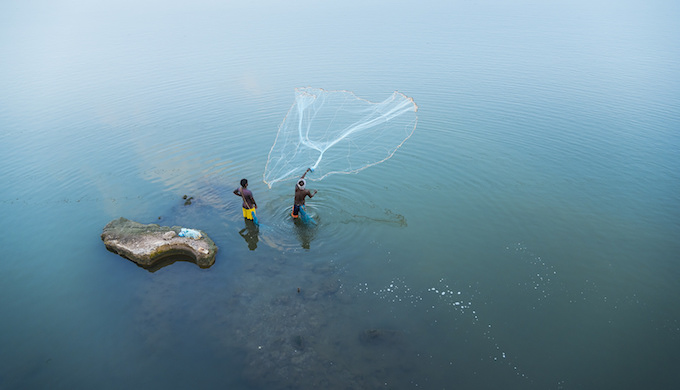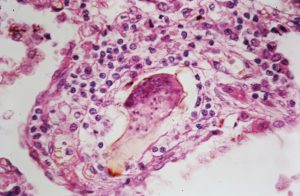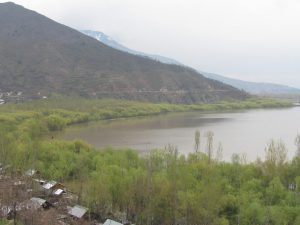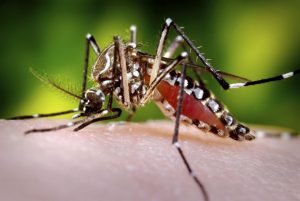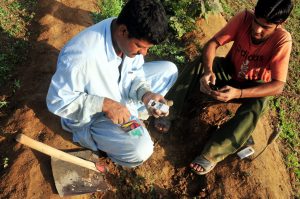The impact of dams on the diversity of fish is a telling example of the unintended consequences of human activity. It is also true that while aquaculture may complement the yield of fisheries, enhance food security and bring in income via exports, it exacerbates coastal vulnerability by decimating mangrove forests. When this is combined with other global warming impacts, it is apparent that India may be about to face a field of landmines — full of dammed-if-you-do and dammed-if-you-don’t scenarios — in managing its food-energy-water nexus.
Mangrove forests are widely quantified and documented by the rich habitats they provide for a large number of species, as well as by their role in carbon capture and as natural defences against storms and coastal erosion. Agriculture and aquaculture are among the major contributors to the loss of mangrove forests around the world, and India and Bangladesh are not immune.
Hydrological barriers
Building dams and other hydrological barriers also affect mangrove forests by choking off sediment loading, while increasing nutrient pollution. Some of the impacts of these barriers on fish diversity are set out in a recent study by the Ashoka Trust for Research in Ecology and the Environment (ATREE), a Bangalore-based research organisation.
See more: The impacts of of dams on the fisheries of the Mekong
The study compared the different species found upstream and downstream of dams. As this can depend on a number of factors — agriculture, deforestation, urbanisation and location — the study separates all factors to extract just the impact of the hydrological barriers and found that the impact on the number of species is felt most immediately downstream. It also found that the recovery of species numbers downstream is enhanced by an increase in the amount of dissolved oxygen in the water, but hampered by an increase in alkalinity.
Reducing the number of dams, barrages or other barriers increases the potential for species to recover — that’s the main message of the study. While this may sound intuitive, it also offers guidance for managing watersheds to navigate the food-energy-water nexus.
But as the old saying goes, nature makes the rules and biology finds the loopholes. More studies are clearly needed to identify the species of fish that are more resilient to hydrological barriers and other habitat disruptions, and to explore whether any novel genetic approaches could transfer their resilience to more vulnerable species.
Considering the challenges of managing the food-energy-water nexus, our own resilience depends on making fish more resilient to our actions, as well as farming food and fish without destroying mangroves.
Coastal vulnerability
It seems that no discussion on climate change-related sea level rise is complete without a mention of the Ganga-Brahmaputra delta, and the vulnerability of Bangladesh. The other oft-mentioned trend is the rapid and monotonic warming of the Indian Ocean, even though it is now known that sea surface temperature warming is more rapid over the western Arabian Sea.
See more: Mangroves: the forests of the tide
A reduction in marine productivity in the Indian Ocean has been observed for several decades, which is seen in reduced fish yields. This can affect the food security of the countries bordering the ocean, all while India’s burgeoning middle class seeks more and more protein from meat and fish. At five to eight kilogrammes per capita per year, India’s average fish consumption is currently half that of the rest of the world, but growing consumption patterns are highly correlated with income levels and so demand can be expected to grow.
The global demand for high-value fisheries products, such as shrimp, is fuelling aquaculture investments in India. Fisheries in the country have grown more than 10 times since independence and nearly a third of the economic value of fisheries comes from exports. India is now second only to China in aquaculture, with a yield of more than four million tonnes a year. At around 1%, the contribution of India’s fisheries to the country’s GDP may seem low, but it does not account for the overall impact in terms of the employment of over 15 million people.
India’s 8,000 kilometres of coastline and its extensive river system offer a high potential for aquaculture, and the sector’s growth in the last two decades indicates that the potential is still to be fully exploited in the years to come. Aquaculture now contributes nearly 50% of the total fish production of more than 10 million tonnes per year. And this figure is expected to grow.
Climate change impacts such as sea level rises interact in unforeseen ways with fisheries and aquaculture, as well as with water and energy demands. Given the multitudes of issues, it is an important time to focus on the unintended and unexpected consequences in the natural-human interactions in the food-energy- water nexus.
